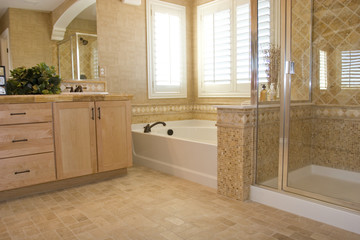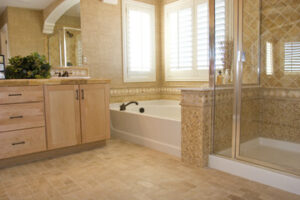
If you take the right precautions – cleaning frequently, sealing properly, directing water flow, using outdoor woven rugs, and more – your deck should be a comfortable and enjoyable place to spend time. But it’s essential to check and fix damages quickly.
Poke around with a screwdriver to see whether any boards are loose or have small holes, which can indicate rot. For more details, check out https://deckbuilderscharleston.com/.
Check the Flashing
The flashing is a vital part of your deck that keeps water from penetrating your home. It’s an L-shaped piece of metal that is often found on the bottom side where a deck meets the house. In order for it to work properly, it must be sealed well. When flashing is missing, the results can be catastrophic for both the deck and the home.
This is especially important when a deck has a sliding door. If the opening is not sealed properly, moisture can cause rotting of the door jamb set and sheathing that can lead to failure of the deck ledger board. A failing ledger board can allow water to leak into the ceiling, walls and rafters of the house, causing extensive damage.
To check the flashing, walk underneath your deck and use a screwdriver to probe areas of wood that appear soft or spongy. The wood should feel firm, but if it’s spongy, it’s a sign of dry rot and needs to be replaced. You should also check joists and posts for spongy, soft or broken wood as well as corroded fasteners.
If you notice any of these issues, be sure to contact a qualified contractor for repair and maintenance. A quick inspection can prevent major problems that could cost you a lot of money and possibly your deck.
Proper deck maintenance also includes trimming bushes and other plants that touch the deck. This not only helps to keep the boards from becoming spongy, but it also makes it more difficult for insect infestations to occur.
Decks should also be inspected for rotted and decaying wood in areas that are exposed to the elements. Using a screwdriver, probe these areas to see if they are spongy or easy to penetrate. If this is the case, the area should be repaired and replaced.
It’s best to inspect the deck in a calm, dry day when there is no rain or wind. This will make the job much easier and will help you to spot problem areas more easily. A good time to do this is during the fall or spring when the weather tends to be more stable.
Check the Nails
Many homeowners and multi-housing units have decks for relaxation, dining and entertaining. It is important to do a periodic survey of the deck to make sure that the deck boards, joists, fasteners and connectors, as well as the stair railings and handrails are sound and in good condition. Inspecting these areas will help you avoid costly repairs or replacements as well as the health and safety issues that come from a neglected deck.
A quick visual inspection may reveal popped nails protruding from the surface of the deck or even empty nail holes. Popped nails are a clue that the wood in the deck is rotting and should be replaced. Resist the temptation to simply pound the popped nail back in place, as this would only provide a temporary fix. Instead, use a screwdriver to probe the area. If the screwdriver sinks in more than about 1/4th inch, the wood is rotting and needs to be replaced.
Another common cause of deck failure is improper attachment to the home. Older decks often had the ledger board nailed to the house, which is not a durable connection. Modern codes require that the ledger board be structurally connected into the home using lag bolts or lag screws.
While it is tempting to use nails at all locations, there are a few places that they should never be used. Joist hangers, for example, are designed to be screwed into the joists. Nails in joist hanger nail holes can corrode and lead to deterioration of the wood, as well as a split between the joist and the hanger that may allow the joist to come loose from the deck.
It is also a good idea to switch from nails to screws when constructing a new deck or rebuilding an existing one. Screws can be less expensive and have a higher tensile strength than nails. Moreover, they can be driven into wood with a power tool without drilling pilot holes, which can help speed construction and reduce labor costs. Screws should be corrosion resistant and long enough to reach the joist on either side.
Check the Railings
A broken railing is the most common cause of deck related injuries. Often, these are due to improper installation and fasteners when the deck was first built. During the inspection, look at each railing to see if it’s securely attached to the post. If the railing is loose or splinters when you touch it, it should be reinforced or replaced as soon as possible.
Look for signs of pest infestation and rot as well. You can also use a screwdriver to poke the surface of each board and feel for soft wood, which could be an indication of dry rot. Infestation and rot tend to spread quickly, so checking frequently will allow you to nip these problems in the bud.
You should also check the ledger board, which connects the deck to your house or other anchoring structure for your deck. Check to ensure that it’s securely fastened and has adequate flashing to protect it from moisture.
The railings and stairs should be free of debris, including leaves and other organic materials that can promote mildew. The stairs should be sturdy and free of splinters and have a smooth, non-skid surface.
While you’re at it, check to see that all the fasteners and nails are secure. Loose screws or nails can lead to rot and other structural damage, especially in areas with high traffic.
If you’re planning on staining your deck, prepare by taping and covering all the hardware that shouldn’t receive stain, such as metal rails, screws and brackets. Then, lightly tap each post and railing with a painter’s tool to see if it feels solid enough to support your weight.
Check the Stairs
During your inspection, look for any signs of structural damage or safety hazards. Carefully examine the joists and beams, looking especially for areas that may have water damage or that seem sagging or uneven. If you find any issues, be sure to address them immediately to prevent future problems and maintain the strength of your deck.
Stairs and railings are the most common areas for deck related injuries. Broken railings can fall and hit people below, while unstable stairs are a hazard for falls. These safety hazards can be easily fixed with a little effort and a trip to the hardware store.
Examine each stair riser and stringer to make sure they are securely fastened to the joists. Replace any nails that have popped up, as well as any splintered or warped boards. Check that handrails are properly fastened and secured to the balusters. Heavily weathered wood should be sanded to remove splinters and ensure the handrail grips are free of any looseness or cracking.
Don’t forget to inspect the guardrails and posts as well, and that they are secure and solidly attached. Stairs should also be inspected to make sure they are secure and free of any rot or sagging. Guardrails and post should be firmly fastened to the foundation or footings, and all of the connections should be tight and solid.
Remember to always use quality paints, stains, and sealants on your deck. The best products will help to repel moisture, protect against mildew and mold, and screen out harmful UV rays. For best results, apply a fresh coat every two to three years.
Keep in mind that new decks require a 60-90 day weathering period before they can be stained or sealed. During this time, the wood will settle and adjust to the environment in which it will be used. After this period, you can apply a fresh coat of stain to your deck. Cover nearby plants with a tarp or plastic sheet to protect them from any overspray from cleaners and stains. Before beginning a deck cleaning project, it’s always a good idea to check the weather forecast to ensure clear and sunny conditions.

